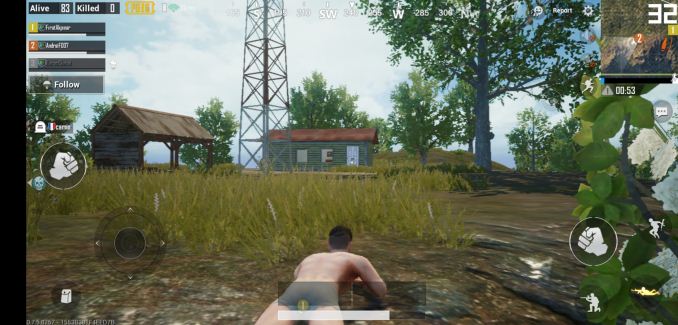Huawei’s GPU Turbo: Valid Technology with Overzealous Marketing
by Ian Cutress & Andrei Frumusanu on September 4, 2018 9:00 AM EST- Posted in
- Smartphones
- Huawei
- Mobile
- Benchmarks
- honor
- Neural Networks
- Kirin 970
- AI
Problems with PUBG: Not All GPUs Render Equally
In part of our testing with PUBG, we did stumble across a particularly alarming scenario which we never really see with standardized testing. When comparing Snapdragon to Kirin, trying to observe Huawei's quoted performance differences, there appears to be a major difference between what Adreno phones were rendering, and what Mali powered phones were rendering and displaying.
Looking into more detail, it’s very obvious that the OnePlus 6 tested here (a Snapdragon/Adreno phone) resulted in far better image quality compared to the other phones.
There are two notable characteristics. First of all, the Adreno render is simply a lot sharper. It looks like the game uses a very different image scaling algorithm. For equality testing, we set the rendering resolution to 720p and upscaled to 1080p on all of the phones. While the Adreno shows up as relatively sharp, the Mali phones are seemingly quite blurry, and this is actually also noticeable on the phone when playing.
The second noticeable element, and arguably more important, is that the Adreno phone actually has anisotropic texture filtering enabled, while the Mali devices are seemingly ignoring it and falling back to bilinear filtering. In a game like PUBG, this is also very noticeable when playing and creates quite big picture quality differences. This also puts quite a differential load on the graphics, resulting in an apples-to-oranges comparison.
Consequently, Huawei’s GPU Turbo marketing comparisons to the competition also are questionable: the anisotropic filtering performance issue can impact framerates by much as 16-18% on its own. Because the Mali GPU devices have this issue, it creates a very unequal comparison when diagnosing performance to such detail. It means that out of the gate, the performance of the Mali phones is already up 16-18%, but at the expense of quality. (Ed: We used to see this a lot in the PC space over 10 years ago, where different GPUs would render different paths or have ‘tricks’ to reduce the workload. They don’t anymore.)
It’s also to be noted that while the Mali devices actually should have a workload advantage given that they’re not doing nearly as much texture filtering work as the Adreno, the performance and efficiency of the Adreno smartphones is still better. Although admittedly the differences are minor given that the game caps out at a maximum of 40fps at maximum quality. That only leaves power efficiency as the metric.
For power efficiency, even with the difference in rendering paths and quality, here Snapdragon 845 phones have a massive advantage, playing the game at 2.5-3W with AF enabled, while the Kirin 970 phones routinely average at 4-4.5W. The higher power consumption and efficiency means that the battery life on those devices will have a deficit.
Real World vs. Synthetic Testing
While I fully understand Huawei’s focus on real-world performance comparison in PUBG rather than synthetic benchmarks, we use synthetic benchmarks to determine the varacity of new features for a good reason – they are industry standards and well understood. Honor’s and Huawei’s marketing focus on PUBG seems a bit poorly thought out when it comes to actual technical comparisons in that regard, which we address on the next page.
There is the added aspect of different GPUs not even rendering the same graphics path, as described below: the fact that Adreno GPUs add anisotropic filtering and have higher quality image scaling effectively means they’re running at a noticeably higher image quality level. This is not taken into account in the performance and efficiency comparisons in Huawei’s materials, lending the materials to be a lot less credible.
The Bottom Line
Still, GPU Turbo is a promising new technology that will give Huawei a competitive edge, all other things being equal. The sad fact here is that for the Kirin 960 and Kirin 970, things are not equal. The competitive landscape will change a lot with the Kirin 980, but until then, current generation device users need have a clear understanding and realistic expectations to what GPU Turbo can actually bring to the table.











64 Comments
View All Comments
mikael.skytter - Monday, September 10, 2018 - link
Hello!Problem on Page 5. There is a large video between the buttons comparing phones and the picture that displays the different phones in PUBG.
Thanks!
/Mikael
Ethos Evoss - Wednesday, September 26, 2018 - link
I just got Huawei Honor Note10 and it has turbo .. :) BEST smartpohne everSuraj tiwari - Thursday, January 31, 2019 - link
Even powervr gpus' r better than mali gpus'. I was surprised when samsung didn't buy powerver but soon realised that bcz they have long contract with ARM & Mali gpus' r cheapannasansers12 - Thursday, April 25, 2019 - link
Huawei's latest feature which is the GPU Turbo technology wishes it's users a good <a href="https://www.itechgyan.com/rules-of-survival-pc/&qu... news </a> for this year. It would really fit to my standard since it doesn't eat much of the battery life and loading of game is quite fast. This phone is really something.